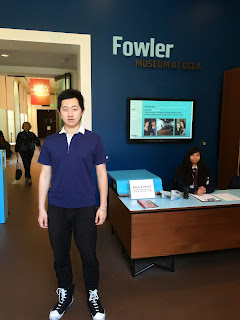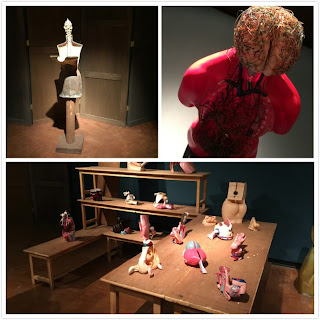I had never been to either
fowler museum or hammer museum before even though I already studied here for
four years and they are just around me, but thanks to our class, which requires
us to visit them so that I would not regret for missing such wonderful places.
After surviving all my midterms last week, finally, I took my adventure to
fowler museum.
The museum is really bigger
inside than what I thought before, especially when I found out such a large
amount of exhibits there. “Making Strange: Gagawaka + Postmortem” is the
exhibition most attractive to me. It consists of two parts and both of them not
only have strong visual impact from aesthetic effect but also involve the
expansions of their meaning. The Gagawaka consists of various wearable,
sculptural garments made from recycled materials and medical supplies. The idea
of combining daily materials and fashion art just corresponds to the theme of
our class, the study and analysis of relationship and connection of different
subjects with art. The garments are made of materials such as sanitary napkins,
respirators, rubber, plastic pipes or even bras.
The immediate inspiration
for me from these garments origins from the most basic aspect: the recycling
usage of daily materials reminds me of its advantage of “turning waste to
wealth” and its realistic meaning in today’s environmental friendly trend. As
Vivan Sundaram speaks, “Fashion is a commodity, but these are sculptural
garments, so they cannot be commodified in the same way. They were produced to
be looked at—and maybe to be worn once in a while. They maintain a tension
between art and design, evoking multidisciplinary elements that are central to
my practice.”(Zehra) I think whatever if the artist himself has the aspiration
or not, his sculptural garments can exhibit as a conceptual lead to people’s
notion of environmental recycling. I remembered in last several world cups, sports
equipment companies like Nike had already developed and manufactured jersey or
even footwear for athletes made from plastic bottles. First, those collected “plastic
bottles are cleaned and shredded into pieces.” Then, these “bits are melted to
become strands of polyester.” After that, “the polyester thread is woven into
premium fabric for high performance apparel.”(Nike.com) The jerseys made up
from plastic bottles are not only a great save of resources but also cheap,
beautiful, light and comfortable. This is one of the realistic examples of
combination of art and recycling technology.
More deeply, “while
Gagawaka was seductive and quirky, Postmortem is decidedly macabre, but
promises to be equally thought-provoking.”(Nidhi) The part postmortem comprises
of mannequins tailors’ dummies, anatomical models, and wooden props used to
present the human body on a more disquieting stage. This kind of artistic expression naturally leads me
to our topic of medical science and art. The combination of it and the former
part let the audience to think about how to draw line between real and
artificial in a consumerist world. The mannequin is structurally available to
being chopped up. One can play with hands and arms. As Sundaram says: “I
explore themes of death and destruction, transforming these objects from
inanimate to sculptural,” In this process of "opening up the body",
he also humanizes the mannequins — seeing them re-configured in this manner
invites, even compels, one to relate to them. (Nidhi) All of these deep and
inspiring ideas through the expression of art combining with medical anatomy
make me fascinated.
Reference:
Jumabhoy, Zehra.
"Artforum." Vivan Sundaram. 20 Dec. 2011. Web. <http://artforum.com/words/id=29889>.
"FROM PLASTIC
TO PERFORMANCE." Nike Better World. Web.
<http://www.nike.com/us/en_us/c/better-world/recycled/innovation>.
Gupta, Nidhi.
"Split Wide Open: Vivan Sundaram Takes Back the Body." The Sunday
Guardian. 2 Nov. 2013. Web.
<http://www.sunday-guardian.com/artbeat/split-wide-open-vivan-sundaram-takes-back-the-body>.




No comments:
Post a Comment